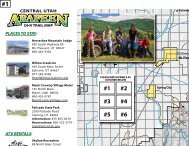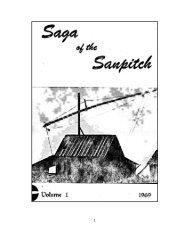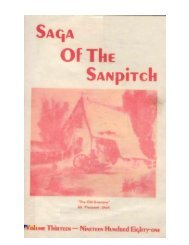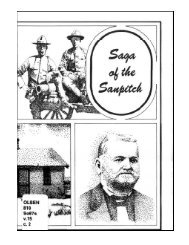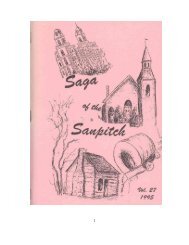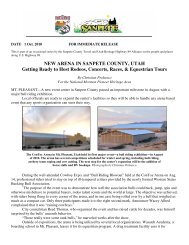Saga of the Sanpitch Volume 17, 1985 - Sanpete County
Saga of the Sanpitch Volume 17, 1985 - Sanpete County
Saga of the Sanpitch Volume 17, 1985 - Sanpete County
You also want an ePaper? Increase the reach of your titles
YUMPU automatically turns print PDFs into web optimized ePapers that Google loves.
sagebrush. It wasn't until 1907 that approval was given by <strong>the</strong> First Presidency <strong>of</strong> <strong>the</strong> church for landscape<br />
improvements. At this time <strong>the</strong> original terrace walls surrounding <strong>the</strong> grounds were removed with <strong>the</strong><br />
exception <strong>of</strong> <strong>the</strong> lower one "which was lowered by one half and <strong>the</strong> hill was graded to cone shape." Tons <strong>of</strong><br />
rich soil were hauled upon <strong>the</strong> hill and covered <strong>the</strong> once solid stone bed, making it possible to plant lawns and<br />
flowers.<br />
Before <strong>the</strong> beautification program commenced, <strong>the</strong> climb up <strong>the</strong> hill to enter <strong>the</strong> temple required<br />
strength and fortitude. Loren D. Squire, who went to <strong>the</strong> temple to be baptized <strong>the</strong> day after his eighth<br />
birthday, January 3, 1906, describes it this way, "My fa<strong>the</strong>r had taken my mo<strong>the</strong>r and I to <strong>the</strong> foot <strong>of</strong> temple<br />
hill on <strong>the</strong> west end <strong>of</strong> <strong>the</strong> hill. . .Mo<strong>the</strong>r and I started up a zig-zag trail from <strong>the</strong> road up <strong>the</strong> steep, rockcovered<br />
hill to <strong>the</strong> west end <strong>of</strong> <strong>the</strong> temple. At each corner <strong>of</strong> <strong>the</strong> zig-zag trail was a cedar post set in <strong>the</strong><br />
ground and a 1 1/2 inch rope was anchored from post to post as a rail to help those climbing <strong>the</strong> hill. After<br />
reaching <strong>the</strong> temple we went inside where we were guided to a room for me to change into white clothing<br />
ready for baptism."<br />
There was need for better steps than <strong>the</strong> zigzag trail. A beautiful, elaborate stairway was constructed,<br />
leading from <strong>the</strong> street level and connecting with <strong>the</strong> roadway surrounding <strong>the</strong> temple on <strong>the</strong> west side. The<br />
stairway was 20 feet wide with retaining walls on ei<strong>the</strong>r side and with square pillars at each landing. These<br />
pillars were fitted for electric lights. There were 125 steps with nine landings. Including <strong>the</strong> cement and iron,<br />
<strong>the</strong>re was a total <strong>of</strong> 2,500,000 pounds <strong>of</strong> material in <strong>the</strong> stairway. It took four months to construct.<br />
The stone stairway bordering <strong>the</strong> sou<strong>the</strong>ast driveway and leading to <strong>the</strong> east entrance <strong>of</strong> <strong>the</strong> building<br />
has 80 steps and is also a magnificent piece <strong>of</strong> work. In 1940 <strong>the</strong> west steps were torn out and lawn was<br />
planted. O<strong>the</strong>r lawn was added later on <strong>the</strong> south slope <strong>of</strong> <strong>the</strong> hill.<br />
During <strong>the</strong> time L. R. Anderson was president <strong>of</strong> <strong>the</strong> temple, he told <strong>of</strong> a vision he had. The experience<br />
was related by Glen A. Nelson <strong>of</strong> Manti who was hired by <strong>the</strong> Oakland Construction Company to use his truck<br />
in building <strong>the</strong> south parking lot. Glen said, "President Anderson put his one arm around me and waving his<br />
o<strong>the</strong>r hand back and forth, he said, 'Bro<strong>the</strong>r Nelson, some day this will be <strong>the</strong> most beautiful spot <strong>of</strong> <strong>the</strong> entire<br />
temple hill. I don't know what it is that's going to happen. You will live to see it, but I will not, but <strong>the</strong>re will be<br />
thousands <strong>of</strong> people come to this hillside. . . I will not see it but you will.'" Glen thought in his mind that it<br />
must be <strong>the</strong> ga<strong>the</strong>ring <strong>of</strong> <strong>the</strong> ten tribes or some such event during <strong>the</strong> millenium, but he concluded, saying,<br />
"Now I know he envisioned <strong>the</strong> Mormon Miracle Pageant which his own son, R. Clair Anderson, was instrumental<br />
in starting, which sees over a hundred thousand yearly come to <strong>the</strong> spot L. R. Anderson was talking<br />
about."<br />
Each temple president has assumed <strong>the</strong> responsibility <strong>of</strong> keeping <strong>the</strong> temple well cared for and has<br />
made those improvements which <strong>the</strong> First Presidency has approved. Changes have come slowly or in phases.<br />
Parking lots have been improved and constructed. Electric lighting was installed in channels which were<br />
miraculously left in <strong>the</strong> original construction. The exterior lighting <strong>of</strong> <strong>the</strong> temple has "created a nightly beacon,<br />
visible for many miles across <strong>the</strong> valley floor."<br />
Ano<strong>the</strong>r miracle is <strong>the</strong> temple spring, which is situated about a mile east <strong>of</strong> <strong>the</strong> temple. The flow <strong>of</strong> <strong>the</strong><br />
spring has increased as <strong>the</strong> temple needs have increased.<br />
The annex on <strong>the</strong> north has also gone through many changes„ Extensive remodeling between 1935-<br />
1940 provided more space for records, <strong>of</strong>fices, a cafeteria and service rooms. Later, a reception room was<br />
added and a heating plant was moved from <strong>the</strong> basement <strong>of</strong> <strong>the</strong> annex to a building immediately east <strong>of</strong> <strong>the</strong><br />
temple. A visitor's center was built to provide information and to serve as a missionary tool. Members <strong>of</strong> <strong>the</strong><br />
church from Manti and surrounding communities have also availed <strong>the</strong>mselves <strong>of</strong> <strong>the</strong> services at <strong>the</strong> center in<br />
<strong>the</strong> use <strong>of</strong> materials and films.<br />
In 1946 considerable cleaning and renovating were done in <strong>the</strong> building. The murals in <strong>the</strong> Garden<br />
69



